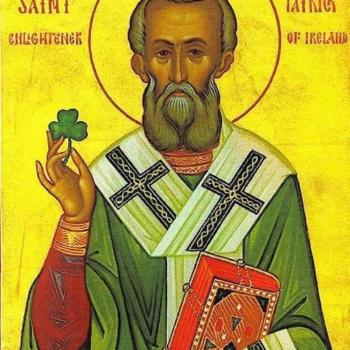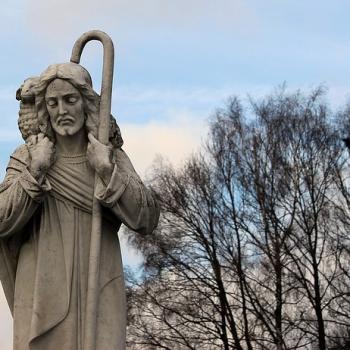One of the most haunting and stunning films in history, The Night of the Hunter (1955), tells the story of a psychopathic preacher, Harry Powell (Robert Mitchum, above), who tries to track down the widow of a man recently hanged for murder. Convinced that she, or her children, can show him where the proceeds of her husband's robbery are concealed, he claims that God has told him to use the money to build a chapel and to kill any wicked women, if necessary, who stand in his way.
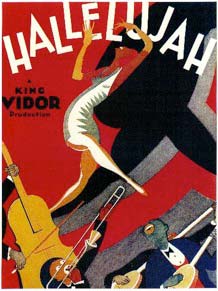 Race often complicates the representation of Protestant ministers in film, the most notorious of which remains Hallelujah! (1929), King Vidor's attempt to provide an authentic look at African Americans and their religious sensibilities. In telling the story of Zeke (Daniel Haynes), a ne'er-do-well who becomes a preacher, veers off the straight and narrow, and finally recommits his life to God, Vidor only reinforces white prejudices about African Americans.
Race often complicates the representation of Protestant ministers in film, the most notorious of which remains Hallelujah! (1929), King Vidor's attempt to provide an authentic look at African Americans and their religious sensibilities. In telling the story of Zeke (Daniel Haynes), a ne'er-do-well who becomes a preacher, veers off the straight and narrow, and finally recommits his life to God, Vidor only reinforces white prejudices about African Americans.
Three other notable films of this type are Hawaii (1966), Sadie Thompson (1928), and Rain (1932). In the former, Max von Sydow plays a missionary to Hawaii who oppresses the very people he hopes to convert by attempting to force them into the straightjacket of his own beliefs without attempting to understand their ways. In the latter two films -- two versions of the same story -- a missionary tries to convert a former prostitute and, upon doing so, falls for her and seduces her, only to drown himself the following morning.
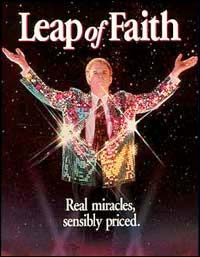 Frauds
Frauds
In most films, frauds appear to be faith healers who rely on gimmicks or plants in the audience to effect a miracle. In Leap of Faith (1992), Jonas Nightengale (Steve Martin) is a fraudulent traveling faith healer who uses a wealth of tricks to con his congregants. However, his big-city success encounters small-town difficulties, namely in the form of a love interest and a sheriff (Liam Neeson).
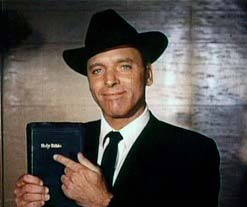 Perhaps the most famous example of ministers as frauds remains Elmer Gantry (1960), which stars Burt Lancaster in the lead role as a traveling salesman who discovers the lucrative aspect of hell-fire and damnation sermonizing. The film exposes the fake emotionalism and financial wheeling and dealing of big business evangelism. Oscars went to Lancaster as Best Actor, to Shirley Jones for Supporting Actress, and to Richard Brooks for Best Screenplay.
Perhaps the most famous example of ministers as frauds remains Elmer Gantry (1960), which stars Burt Lancaster in the lead role as a traveling salesman who discovers the lucrative aspect of hell-fire and damnation sermonizing. The film exposes the fake emotionalism and financial wheeling and dealing of big business evangelism. Oscars went to Lancaster as Best Actor, to Shirley Jones for Supporting Actress, and to Richard Brooks for Best Screenplay.
Elmer Gantry found a real-life parallel in the 1972 Best Documentary Oscar winning Marjoe, which tells the story of the evangelist Marjoe Gortner, who, at the age of four, began leading revivals and even conducting marriages. Preaching in the fiery style of so many Pentecostal evangelists, his sermons were highly energetic fire and brimstone proclamations; though he gradually loses faith in his message, he continues to preach for the money.
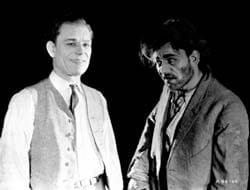 Even as far back as 1919, we find fraudulent ministers. The Miracle Man (1919), which starred the soon-to-be-famous Lon Chaney (above in and out of costume), tells the story of a faith healer and the petty crooks and fake cripples who attempt to exploit him; surprisingly, they are brought to repentance. This film complicates this particular type because the fake participants actually experience a spiritual healing. The most notable feature of this film, however, might be Chaney himself, whose physical stunts and contortions to fit his roles, especially where he plays a fake crippled man whose legs are deformed and twisted, often left him in great pain.
Even as far back as 1919, we find fraudulent ministers. The Miracle Man (1919), which starred the soon-to-be-famous Lon Chaney (above in and out of costume), tells the story of a faith healer and the petty crooks and fake cripples who attempt to exploit him; surprisingly, they are brought to repentance. This film complicates this particular type because the fake participants actually experience a spiritual healing. The most notable feature of this film, however, might be Chaney himself, whose physical stunts and contortions to fit his roles, especially where he plays a fake crippled man whose legs are deformed and twisted, often left him in great pain.

